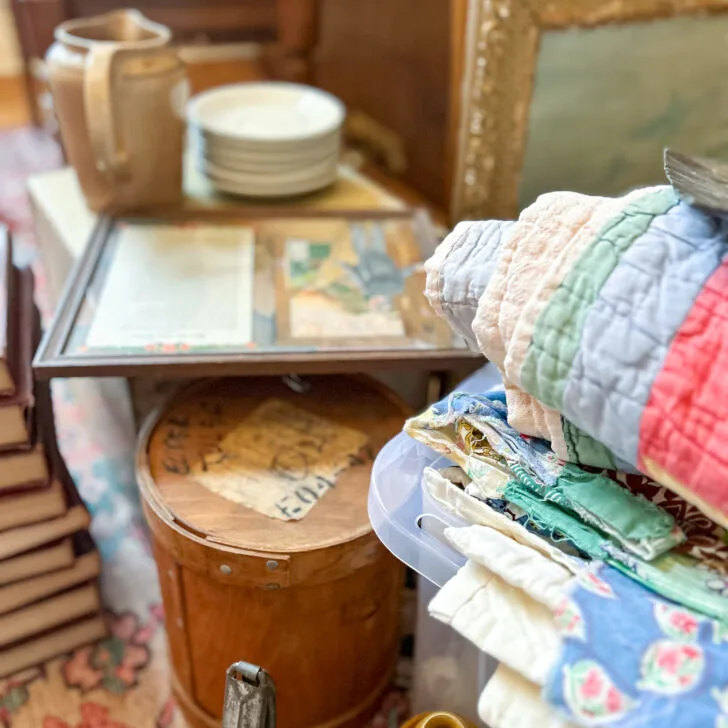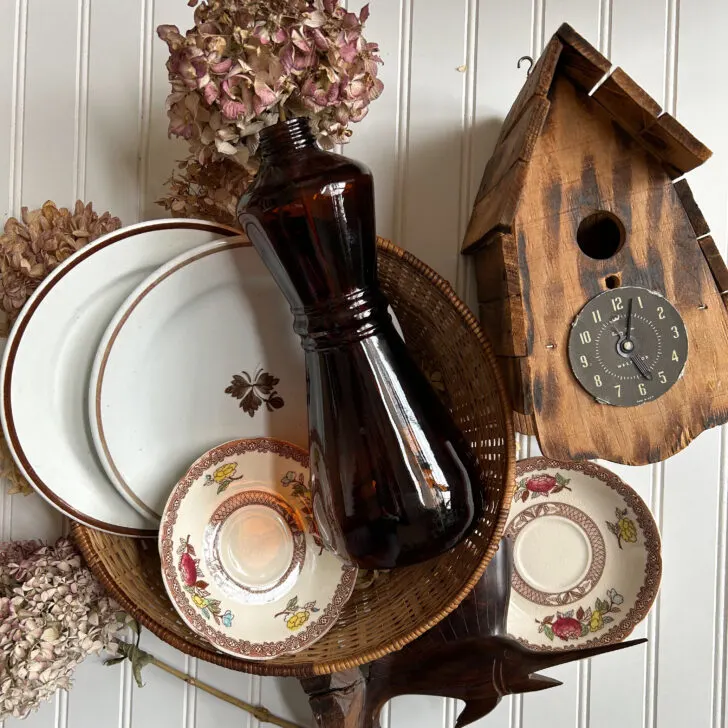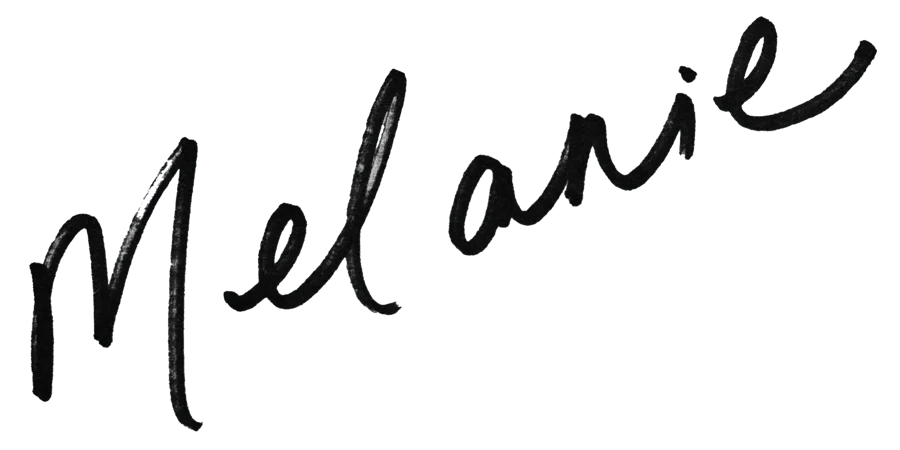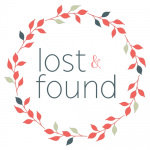At some point in your journey as a vintage or antique reseller, you’ve likely created one: the dreaded doom pile.
You know the one—it’s that growing stash of unsorted, unlisted, untagged inventory sitting in your garage, your basement, or your storage unit. You meant to get to it, but the thrill of the hunt kept calling, and you just had to bring home that next great haul.
It happens to the best of us. But here’s the truth: that doom pile is quietly costing you—money, time, and maybe even your sanity.
It’s time to tackle it once and for all, and this post will give you the step-by-step plan you need to do just that.

Why You Need to Clear Your Vintage Reseller Doom Pile
If I had a dollar for every vintage dealer or antique booth owner who mentioned their “just-in-case” stash of extra inventory—stored in totes, stacked in garages, or hiding in rented units—I’d be one wealthy lady.
The truth is, overbuying is one of the most common struggles for resellers. So if you’re staring at a mountain of dusty inventory and wondering how it got this bad, you’re not alone.
It’s easy to justify. Extra inventory means you’re ready to restock, right?
Well… sort of.
While having a little backup is smart, too much inventory becomes a drag on your business. Here’s why:
-
Slower inventory turnover = slower cash flow and reduced profits.
-
Poor pricing decisions because you forgot what you paid or where the item even came from.
- Trendy items lose value over time. Buy it in January, and by July, the trend may have passed.
-
Storage costs eat into your margins (and your garage space).
-
Emotional clutter and overwhelm make your business feel heavier than it should.
So how do you know when you’ve bought too much inventory?
This part is key—and it’s different depending on how you sell.
For booth vendors:
Keep enough inventory to fill your booth (with every item having a designated space), plus extra to replace about half your booth in a month. That’s plenty.
If you sell furniture, I recommend having 1–2 extra pieces waiting in the wings to replace large sellers.
For online sellers:
The temptation is to keep listing endlessly—but that can backfire. Without limits, you’ll find yourself spending every bit of your profit on more stuff, rather than keeping some cash in your pocket.
Instead, set a monthly inventory budget based on your average sales and cost of goods.
Let’s say you sell $2,000/month and typically pay $400 for that inventory—that’s a 20% cost. Great! Stick to that $400 buying budget to maintain a healthy business cycle.
👉 Need help figuring that out? My Business Budget Tracker is perfect for this! It’ll help you calculate what you really can spend without draining your business.
Steps to Clear Out Your Doom Pile in a Week
If you’re ready to stop the cycle, here’s a simple 5-day plan to make serious progress—whether you’re full-time or reselling as a side hustle.
Adjust the pace to your schedule: maybe you tackle 50 items or 4 bins instead of the whole pile. The goal is forward motion.
You can repeat this as many times as needed until your pile is all the way gone.
DAY 1: Sort & Clean
Start by opening every tote, box, and bag. Yes, all of them.
As you sort:
-
Trash or donate anything broken, damaged, or completely outdated.
-
Only keep what fits your brand, is in good condition, and has resale potential.
Give everything a quick clean so it’s photo-ready or booth-ready when you’re done.
DAY 2: Pricing
Now that you have your keepers, it’s time to figure out what you paid (or guess, if you must).
-
Can’t remember? Use simple flat-rate costs like $1, $5, or $10 based on the type of item.
-
Add this info to your inventory system or a basic spreadsheet.
-
Then, price your items for resale based on your usual markup.
Booth sellers: Go ahead and tag each item while you’re at it.
Online sellers: Just log the sale price alongside your cost so you’re ready to list.
📌 RELATED POST: How to Pick the Right Price for Your Antique Booth Items

DAY 3: Photograph and Style
Now that everything is sorted, priced, and tagged, you can start having a little more fun with things!
If you’re selling online, take all the photos you need to take today–yes, all. Don’t start listing yet though, we want to stay focused on finishing the photography today.
This is called batching your time, when you break a big project down into bite-sized pieces and complete all of one part of the project before moving on to another.
Working like this helps you stay focused and avoid losing momentum when you switch from one task to another.
If you are a booth seller, today you can spend pre-planning your vignettes. Gather your ideas for how you will stage these new items in your booth, what will go together, and what extra “fluff” you may need to finish out your display.
DAY 4: List or Take
Today it’s time to get your sorted, tagged, and priced doom pile items actually available for sale.
If you’re an online seller, you already have all your photos and prices. So spend today listing all of the back items.
For booth owners, today is the day you drive to your location and move all the items in.
If you don’t have room for everything, it’s ok, you still made major progress this week! For the items that don’t fit, you can organize them back at home for easy restock. Or move onto step #5 if you’r afraid of just starting another doom pile.
DAY 5: Deal with Leftovers
All of the junk you sorted in step one, today is when you can drive it to a donation site. Or if you have extra inventory that doesn’t fit in your booth, you deal with it today.
You can reorganize what you have left, although I suggest limiting yourself to the extra inventory amount suggested above so you don’t backtrack on your progress!
Another idea is to take good quality leftovers and create “vintage decor grab bags” on FB Marketplace. You can bundle items that display well together and list them at a discount.
I’ve had a lot of success with recouping cost on stale or excess inventory this way.

Closing Thoughts on Working Through a Doom Pile
Think you can’t get through your doom pile in a week? That’s okay.
Just set a manageable weekly goal (even one bin or 10 items!) and repeat until it’s gone. Progress is progress.
And most importantly? Don’t buy anything new during this time. Try a No-Buy Month and fall in love with what you already own. Your bank account will thank you—and so will your booth (and your garage).
Once it’s gone, you’ll breathe easier and your business will feel lighter. And you’ll probably notice you’re making more money, too.
Let this be the turning point. No more doom piles—just smart, purposeful inventory decisions from here on out.
Thanks for being with me here today and hope this was helpful!


Liz
Thursday 24th of July 2025
This was a great post and helpful tips for both booth and online sellers! Thank you! I would love to hear your thoughts more on what to do with online inventory that is not selling, when you decide to donate/create 'vintage grab bags', etc.
Melanie Alexander
Monday 18th of August 2025
Hey Liz! Do you have an email list for subscribers and customers? If not, getting that going would be my first to-do. Then I would email those people with a special "clearance" sale on those online items that need to move. What's left after that, try bundling together and listing on FB marketplace for cheaper, just to get cash back. But for online selling, that email list is gonna be key!
Patti M.
Thursday 24th of July 2025
Perfect Timing!Thanks for the tips! I have been working through my doom pile for several weeks. I'm making a lot of progress and it feels great. I have a booth, do monthly vendor shows and sell at a consignment store that has thrift store to high end items and prices. The consignment store will donate any extra items after two months and we get the donation write offs. I am prepping for our move across the country this spring. I have been staying away from thrift stores, but yard sale season is at it's peak... Keeps me busy for sure!